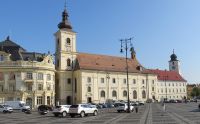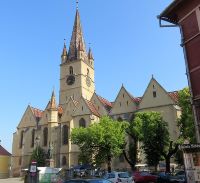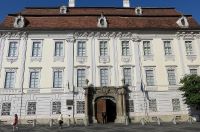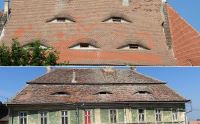Sibiu —
 I sent my blogs from Romania to my colleague, Professor Pana, who commented, “I think you are falling in love with Romania.” She might well be right, as you’ll see when I tell you about my latest encounter with a temptress, the city of Sibiu, or, to give it its German name, Hermannstadt.
I sent my blogs from Romania to my colleague, Professor Pana, who commented, “I think you are falling in love with Romania.” She might well be right, as you’ll see when I tell you about my latest encounter with a temptress, the city of Sibiu, or, to give it its German name, Hermannstadt.
The city was the cultural capital of Europe in 2007–the sewer covers say so–which meant that the European Union lavished money on the refurbishment of what was already a medieval jewel with the expectation that Europeans (and others) would flock to it.
A seductive jewel it was before being polished. One of the cities the King of Hungary invited Germans to settle, in order to protect the Kingdom of Hungary from the Turks (the paintings in the churches from the period have the bad guys in the Christ pictures dressed in Turkish outfits!), it has a distinctly Austro-Hungarian flavor. The Germans got privileges that enabled them to become wealthy, the Reformation led to the formation of Evangelical Lutheran churches that enabled a political and religious semi-autonomy; the subsequent fusion of Sibiu with Hungary (after the reestablishment of Austrian rule and the reconquest of Budapest from the Turks) made the city the seat of the governor, who was usually a German. The subsequent slide in importance left the city (perhaps) too poor to reconstruct everything, so never having been conquered, the old city remained old (supplemented as the city grew by a new city that tourists generally ignore, and for good reason).
My morning consisted of the transfer from the elegant but out-of-centrum Hilton to the more centrally-located Ramada (I’m watching fireworks in the old city from my window right now; ironically, the construction of the Ramada, at 12 stories, botched a bid to have the city included in the UNESCO heritage listing). There then followed a three-hour tour of the most important buildings. It has the trinity–cathedrals, forts, and museums. Of  the cathedrals, the Gothic Catholic Church became the Evangelical Lutheran Church after the Reformation. My understanding is that it got the properties from the Germans who left after World War II, and owns much of the old town; it is the resting place of Vlad the Impaler’s son, who was assassinated here for his father’s misdeeds. There is also a baroque Catholic church, a Hungarian church, and a 1902 Orthodox church that resembles Hagia Sophia in Constantinople.
the cathedrals, the Gothic Catholic Church became the Evangelical Lutheran Church after the Reformation. My understanding is that it got the properties from the Germans who left after World War II, and owns much of the old town; it is the resting place of Vlad the Impaler’s son, who was assassinated here for his father’s misdeeds. There is also a baroque Catholic church, a Hungarian church, and a 1902 Orthodox church that resembles Hagia Sophia in Constantinople.
Of the forts, there’s a series of squares that provided fortification, but none as grand as the walls and the 39 towers that were manned by the merchant guilds (built atop the Roman  ruins). The museums are housed in a variety of merchant/politician buildings. The most spectacular was a palace built by the governor (a German, naturally) in the 1770s, that has a few Breughels and Rubens–pictures he had acquired, but there’s also a museum of ethnography (a 19th century quasi- scientist brought back a variety of artifacts from an expedition to Egypt, so there’s a mummy), a museum dedicated to the guilds, and one that celebrates the area’s role in homeopathic medicine. Perhaps the most distinctive feature
ruins). The museums are housed in a variety of merchant/politician buildings. The most spectacular was a palace built by the governor (a German, naturally) in the 1770s, that has a few Breughels and Rubens–pictures he had acquired, but there’s also a museum of ethnography (a 19th century quasi- scientist brought back a variety of artifacts from an expedition to Egypt, so there’s a mummy), a museum dedicated to the guilds, and one that celebrates the area’s role in homeopathic medicine. Perhaps the most distinctive feature  of the buildings is the eye-shaped windows in the attics. The most Austrian-looking building dates from 1987; I made a bad guess on that one!
of the buildings is the eye-shaped windows in the attics. The most Austrian-looking building dates from 1987; I made a bad guess on that one!
Later in the afternoon, I finally contacted my new best friend, Radu, who is a local Scout leader. He’s been a leader for 12 years, and gave me his view of the city, but more fun, took me to a gathering of his Scouts at the school where they meet. He has mostly 11-14 year old boys and girls, some of whom showed up in uniform, and went blank (more or less) in English, even though they studied it in school. We exchanged mementos and stories for about an hour.
Radu and I were joined by two of the boys for dinner in the old city, at a medieval-looking restaurant in the vaulted cellar of one of the old buildings. Radu and I walked through the fest celebration that was capped with the 20-minute fireworks that just ended.
It was fun to have embraced another Romanian city. I’ll have one more, tomorrow, when I fly from Sibiu to Lvov (in the Ukraine) when I stop briefly in Timisoara, which is another of the Saxon beauties of Romania. My wakeup call is in 5 hours. Goodnight, and happy Memorial Day weekend.